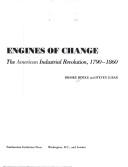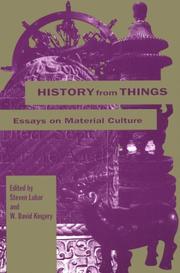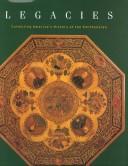| Listing 1 - 10 of 10 |
Sort by
|
Book
ISBN: 0395570425 Year: 1993 Publisher: Boston, Mass. Houghton Mifflin
Abstract | Keywords | Export | Availability | Bookmark
 Loading...
Loading...Choose an application
- Reference Manager
- EndNote
- RefWorks (Direct export to RefWorks)
Book
ISBN: 0674983297 0674982908 Year: 2018 Publisher: Cambridge, MA : Harvard University Press,
Abstract | Keywords | Export | Availability | Bookmark
 Loading...
Loading...Choose an application
- Reference Manager
- EndNote
- RefWorks (Direct export to RefWorks)
For more than two centuries museums have preserved art, artifacts, and natural specimens, engaged and educated the public, and provided resources for research in areas from art history to zoology. Inside the Lost Museum explains the work of museums--collecting, preserving, displaying, and using collections--by considering their remarkable history. Museums make choices about what's worth saving. Inside the Lost Museum explores those choices, and the processes--from donation to purchase to expedition--that shape collections. Once collected, museum objects are numbered, cataloged, and conserved, and sometimes deaccessioned--processes that have their own hows and whys. Museums display art and artifact in many ways, from dioramas and period rooms to paintings on white walls and visual storage. Inside the Lost Museums reveals the meanings of those choices, and the ways that they have changed and continue to change, shaped by new technologies and ideologies. It also argues for the value of museum collections for research, teaching, and community-building. Woven through Inside the Lost Museum is the story of the Jenks Museum of Brown University, a nineteenth-century museum of natural history, anthropology and "curiosities" that disappeared a century ago. The Jenks Museum's history, and a recent effort to re-imagine that museum as art, science and history, serves as a framework for understanding museums' long record of usefulness and service. Inside the Lost Museum considers the lessons museum history holds for museums today and tomorrow.--Provided by publisher.
Book
ISBN: 9780674982901 0674982908 9780674971042 0674971043 Year: 2018 Publisher: Cambridge, MA
Abstract | Keywords | Export | Availability | Bookmark
 Loading...
Loading...Choose an application
- Reference Manager
- EndNote
- RefWorks (Direct export to RefWorks)

ISBN: 087474539X Year: 1988 Publisher: Washington Smithsonian Institution Press
Abstract | Keywords | Export | Availability | Bookmark
 Loading...
Loading...Choose an application
- Reference Manager
- EndNote
- RefWorks (Direct export to RefWorks)
Industrial revolution --- Technological innovations --- 331.12 --- US / United States of America - USA - Verenigde Staten - Etats Unis --- Breakthroughs, Technological --- Innovations, Industrial --- Innovations, Technological --- Technical innovations --- Technological breakthroughs --- Technological change --- Creative ability in technology --- Inventions --- Domestication of technology --- Innovation relay centers --- Research, Industrial --- Technology transfer --- Economic aspects&delete& --- History --- Geschiedenis van de industrie --- United States --- Economic conditions --- Economic aspects

ISBN: 0874745403 Year: 1986 Publisher: Washington and London : Smithsonian Institution Press,
Abstract | Keywords | Export | Availability | Bookmark
 Loading...
Loading...Choose an application
- Reference Manager
- EndNote
- RefWorks (Direct export to RefWorks)
Book
ISBN: 9780674971042 0674971043 Year: 2017 Publisher: Cambridge, Massachusetts London, England Harvard University Press
Abstract | Keywords | Export | Availability | Bookmark
 Loading...
Loading...Choose an application
- Reference Manager
- EndNote
- RefWorks (Direct export to RefWorks)
For more than two centuries museums have preserved art, artifacts, and natural specimens, engaged and educated the public, and provided resources for research in areas from art history to zoology. Inside the Lost Museum explains the work of museums--collecting, preserving, displaying, and using collections--by considering their remarkable history. Museums make choices about what's worth saving. Inside the Lost Museum explores those choices, and the processes--from donation to purchase to expedition--that shape collections. Once collected, museum objects are numbered, cataloged, and conserved, and sometimes deaccessioned--processes that have their own hows and whys. Museums display art and artifact in many ways, from dioramas and period rooms to paintings on white walls and visual storage. Inside the Lost Museums reveals the meanings of those choices, and the ways that they have changed and continue to change, shaped by new technologies and ideologies. It also argues for the the value of museum collections for research, teaching, and community-building. Woven through Inside the Lost Museum is the story of the Jenks Museum of Brown University, a nineteenth-century museum of natural history, anthropology and "curiosities" that disappeared a century ago. The Jenks Museum's history, and a recent effort to re-imagine that museum as art, science and history, serves as a framework for understanding museums' long record of usefulness and service. Inside the Lost Museum considers the lessons museum history holds for museums today and tomorrow.--

ISBN: 1560982047 Year: 1993 Publisher: Washington, D.C. Smithsonian Institution Press
Abstract | Keywords | Export | Availability | Bookmark
 Loading...
Loading...Choose an application
- Reference Manager
- EndNote
- RefWorks (Direct export to RefWorks)
History as a science --- Archaeology and history. --- Material culture.

ISBN: 9781560986133 1560982047 9781560982043 1560986131 Year: 1993 Publisher: Washington Smithsonian Institution Press
Abstract | Keywords | Export | Availability | Bookmark
 Loading...
Loading...Choose an application
- Reference Manager
- EndNote
- RefWorks (Direct export to RefWorks)
History from Things explores the many ways objects - defined broadly to range from Chippendale tables and Italian Renaissance pottery to seventeenth-century parks and a New England cemetery - can reconstruct and help to reinterpret the past. Eighteen essays describe how to "read" artifacts, how to "listen to" landscapes and locations, and how to apply methods and theories to historical inquiry that have previously belonged solely to archaeologists, anthropologists, art historians, and conservation scientists. The contributors demonstrate that artifacts can be prime historical evidence that discloses important facts about the nature of past cultures. The book shows how, for example, the detailed examination of Chinese Zhou bronzes revealed that a factory system of production - nowhere attested to in documentary sources - existed in China as early as the fifth century B.C. Spanning vast time periods, geographical locations, and academic disciplines, History from Things leaps the boundaries between fields that use material evidence to understand the past. It expands and redirects the study of material culture - an emerging field now building a common base of theory and a shared intellectual agenda.
Archaeology and history --- Material culture --- Culture --- History --- Folklore --- Technology --- Historical archaeology --- History and archaeology

ISBN: 156098886X Year: 2001 Publisher: Washington London Smithsonian Institution Press ; in association with the National Museum of American History, Behring Center
Abstract | Keywords | Export | Availability | Bookmark
 Loading...
Loading...Choose an application
- Reference Manager
- EndNote
- RefWorks (Direct export to RefWorks)
Book
ISBN: 1476629196 9781476629193 9781476669212 Year: 2017 Publisher: Jefferson, NC
Abstract | Keywords | Export | Availability | Bookmark
 Loading...
Loading...Choose an application
- Reference Manager
- EndNote
- RefWorks (Direct export to RefWorks)
"Brown & Sharpe employees produced and marketed measuring devices, machine tools and precision machinery, and helped shape Rhode Island, the nation and the modern world. The history of Brown & Sharpe contains the story of the Industrial Revolution in America, covering more than 150 years of technological development, labor history and public policy, culminating in history's longest strike"--
Machinery industry --- Labor --- Technological innovations --- Industrial revolution --- History. --- Brown & Sharpe Manufacturing Company (Providence, R.I.) --- United States --- Social policy.
| Listing 1 - 10 of 10 |
Sort by
|

 Search
Search Feedback
Feedback About UniCat
About UniCat  Help
Help News
News